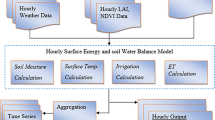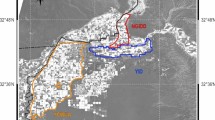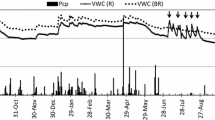Abstract
Winter vegetables, including lettuce, are a significant consumptive use of water in the Lower Colorado River Basin. Precise irrigation management is needed to increase water use efficiency and reduce the negative impacts of suboptimal irrigation, including nutrient leaching, crop stress, and crop pathogens. However, lettuce has multiple features that make accurate evapotranspiration (ET) modeling difficult, including asynchronicity with meteorological evaporative demand, short growing seasons, and a shallow root zone that increases the risk of using an incorrect ET value. To improve ET modeling and understand applied irrigation effectiveness for lettuce in this region, we used an energy and water balance bio-physical model, Backward-Averaged Iterative Two-Source Surface temperature and energy balance Solution (BAITSSS) on arid farmlands in the lower Colorado River basin. The study was conducted between 2016 and 2020 at twelve eddy covariance (EC) sites in lettuce with a wide range of soil physical properties. BAITSSS was implemented using ground-based weather and irrigation data, and remote sensing-based vegetation indices (Sentinel-2). The model accuracy varied among sites, with a mean cumulative seasonal ET of ~ 3% and mean RMSE of 1.1 mm d−1 when compared to EC. The results showed that accurate timing and amount of applied water (irrigation and precipitation) were critical to capturing ET spikes right after irrigation and tracking the continuous decrease of ET. This study highlighted the dominant factors that influence the ET of lettuce and how BAITSSS can improve ET modeling for irrigation management.







Similar content being viewed by others
Notes
Mention of trade names or commercial products in this publication is solely for the purpose of providing specific information and does not imply recommendation or endorsement by the U.S. Department of Agriculture.
References
Alexandridis TK, Panagopoulos A, Galanis G et al (2014) Combining remotely sensed surface energy fluxes and GIS analysis of groundwater parameters for irrigation system assessment. Irrig Sci 32:127–140. https://doi.org/10.1007/s00271-013-0419-8
Allen RG, Pereira LS, Raes D, Smith M (1998) Crop evapotranspiration-guidelines for computing crop water requirements-FAO Irrigation and drainage paper 56. Fao, Rome 300:D05109
Allen RG, Pereira LS, Smith M et al (2005a) FAO-56 dual crop coefficient method for estimating evaporation from soil and application extensions. J Irrig Drain Eng 131:2–13. https://doi.org/10.1061/(ASCE)0733-9437(2005)131:1(2)
Allen RG, Walter IA, Elliot R, et al (2005b) The ASCE standardized reference evapotranspiration equation. ASCE-EWRI task committee final report
Anderson RG, Wang D (2014) Energy budget closure observed in paired Eddy Covariance towers with increased and continuous daily turbulence. Agric Forest Meteorol 184:204–209
Anderson MC, Yang Y, Xue J et al (2021) Interoperability of ECOSTRESS and Landsat for map** evapotranspiration time series at sub-field scales. Remote Sens Environ 252:112189. https://doi.org/10.1016/j.rse.2020.112189
Anderson MC, Norman JM, Mecikalski JR et al (2007) A climatological study of evapotranspiration and moisture stress across the continental United States based on thermal remote sensing: 1. Model formulation: evapotranspiration and moisture stress. J Geophys Res. https://doi.org/10.1029/2006JD007506
Arguez A, Durre I, Applequist S, et al (2010) U.S. Climate Normals Product Suite (1981–2010)
Ball JT, Woodrow IE, Berry JA (1987) A Model Predicting Stomatal Conductance and its Contribution to the Control of Photosynthesis under Different Environmental Conditions. In: Biggins J (ed) Progress in Photosynthesis Research. Springer, Netherlands, pp 221–224
Berardy A, Chester MV (2017) Climate change vulnerability in the food, energy, and water nexus: concerns for agricultural production in Arizona and its urban export supply. Environ Res Lett 12:035004. https://doi.org/10.1088/1748-9326/aa5e6d
Bohn TJ, Vivoni ER (2016) Process-based characterization of evapotranspiration sources over the North American monsoon region. Water Resour Res 52:358–384. https://doi.org/10.1002/2015WR017934
Chikamoto Y, Wang S-YS, Yost M et al (2020) Colorado River water supply is predictable on multi-year timescales owing to long-term ocean memory. Commun Earth Environ 1:26. https://doi.org/10.1038/s43247-020-00027-0
Dhungel R, Allen RG, Trezza R, Robison CW (2016) Evapotranspiration between satellite overpasses: methodology and case study in agricultural dominant semi-arid areas: Time integration of evapotranspiration. Met Apps 23:714–730. https://doi.org/10.1002/met.1596
Dhungel R, Aiken R, Colaizzi PD et al (2019a) Evaluation of uncalibrated energy balance model (BAITSSS) for estimating evapotranspiration in a semiarid, advective climate. Hydrol Process 33:2110–2130. https://doi.org/10.1002/hyp.13458
Dhungel R, Aiken R, Colaizzi PD et al (2019b) Increased bias in evapotranspiration modeling due to weather and vegetation indices data sources. Agron J 111:1407–1424. https://doi.org/10.2134/agronj2018.10.0636
Dhungel R, Aiken R, Evett SR et al (2021) Energy imbalance and evapotranspiration hysteresis under an advective environment: evidence from lysimeter, Eddy covariance, and energy balance modeling. Geophys Res Lett. https://doi.org/10.1029/2020GL091203
Erie LJ, French OF, Bucks DA, Harris K (1982) Consumptive Use of Water by Major Crops in the Southwestern United States
Esau I, Miles VV, Davy R et al (2016) Trends in normalized difference vegetation index (NDVI) associated with urban development in northern West Siberia. Atmos Chem Phys 16:9563–9577. https://doi.org/10.5194/acp-16-9563-2016
Escarabajal-Henarejos D, Molina-Martínez JM, Fernández-Pacheco DG, García-Mateos G (2015) Methodology for obtaining prediction models of the root depth of lettuce for its application in irrigation automation. Agric Water Manag 151:167–173. https://doi.org/10.1016/j.agwat.2014.10.012
Evett SR, Schwartz RC, Howell TA et al (2012) Can weighing lysimeter ET represent surrounding field ET well enough to test flux station measurements of daily and sub-daily ET? Adv Water Resour 50:79–90. https://doi.org/10.1016/j.advwatres.2012.07.023
Falge E, Baldocchi D, Olson R et al (2001) Gap filling strategies for long term energy flux data sets. Agric for Meteorol 107:71–77. https://doi.org/10.1016/S0168-1923(00)00235-5
Fisher JB, Melton F, Middleton E et al (2017) The future of evapotranspiration: Global requirements for ecosystem functioning, carbon and climate feedbacks, agricultural management, and water resources: The future of evapotranspiration. Water Resour Res 53:2618–2626. https://doi.org/10.1002/2016WR020175
Fratini G, Mauder M (2014) Towards a consistent eddy-covariance processing: an intercomparison of EddyPro and TK3. Atmos Measur Techn 7:2273–2281
French AN, Hunsaker DJ, Sanchez CA et al (2020) Satellite-based NDVI crop coefficients and evapotranspiration with eddy covariance validation for multiple durum wheat fields in the US Southwest. Agric Water Manag 239:106266. https://doi.org/10.1016/j.agwat.2020.106266
Frisvold G, Sanchez C, Gollehon N et al (2018) Evaluating gravity-flow irrigation with lessons from Yuma, Arizona, USA. Sustainability 10:1548. https://doi.org/10.3390/su10051548
Gallardo M, Snyder RL, Schulbach K, Jackson LE (1996) Crop growth and water use model for Lettuce. J Irrig Drain Eng 122:354–359. https://doi.org/10.1061/(ASCE)0733-9437(1996)122:6(354)
Gutman G, Ignatov A (1998) The derivation of the green vegetation fraction from NOAA/AVHRR data for use in numerical weather prediction models. Int J Remote Sens 19:1533–1543. https://doi.org/10.1080/014311698215333
He R, ** Y, Kandelous M et al (2017) Evapotranspiration estimate over an almond Orchard using landsat satellite observations. Remote Sensing 9:436. https://doi.org/10.3390/rs9050436
Jarvis PG (1976) The interpretation of the variations in leaf water potential and stomatal conductance found in canopies in the field. Phil Trans R Soc Lond B 273:593–610. https://doi.org/10.1098/rstb.1976.0035
Johnson LF, Trout TJ (2012) Satellite NDVI assisted monitoring of vegetable crop evapotranspiration in California’s San Joaquin valley. Remote Sensing 4:439–455. https://doi.org/10.3390/rs4020439
Johnson LF, Cahn M, Martin F et al (2016) Evapotranspiration-based irrigation scheduling of head lettuce and broccoli. HortScience 51:935–940
Kilic A, Allen R, Trezza R et al (2016) Sensitivity of evapotranspiration retrievals from the METRIC processing algorithm to improved radiometric resolution of Landsat 8 thermal data and to calibration bias in Landsat 7 and 8 surface temperature. Remote Sens Environ 185:198–209. https://doi.org/10.1016/j.rse.2016.07.011
Kljun N, Calanca P, Rotach MW, Schmid HP (2015) A simple two-dimensional parameterisation for Flux Footprint Prediction (FFP). Geoscient Model Develop 8:3695–3713. https://doi.org/10.5194/gmd-8-3695-2015
Kumar A, Chen F, Niyogi D et al (2011) Evaluation of a photosynthesis-based Canopy resistance formulation in the Noah Land-surface model. Boundary-Layer Meteorol 138:263–284. https://doi.org/10.1007/s10546-010-9559-z
Leuning R (1990) Modelling stomatal behaviour and and photosynthesis of eucalyptus grandis. Function Plant Biol 17:159. https://doi.org/10.1071/PP9900159
Leuning R (1995) A critical appraisal of a combined stomatal-photosynthesis model for C3 plants. Plant Cell Environ 18:339–355. https://doi.org/10.1111/j.1365-3040.1995.tb00370.x
Leuning R, van Gorsel E, Massman WJ, Isaac PR (2012) Reflections on the surface energy imbalance problem. Agric Forest Meteorol 156:65–74. https://doi.org/10.1016/j.agrformet.2011.12.002
Lhomme J-P, Elguero E, Chehbouni A, Boulet G (1998) Stomatal control of transpiration: Examination of Monteith’s formulation of canopy resistance. Water Resour Res 34:2301–2308. https://doi.org/10.1029/98WR01339
Liu B, Cui Y, Shi Y et al (2019) Comparison of evapotranspiration measurements between eddy covariance and lysimeters in paddy fields under alternate wetting and drying irrigation. Paddy Water Environ 17:725–739. https://doi.org/10.1007/s10333-019-00753-y
Long D, Singh VP (2010) Integration of the GG model with SEBAL to produce time series of evapotranspiration of high spatial resolution at watershed scales. J Geophys Res 115:D21128. https://doi.org/10.1029/2010JD014092
Lund J, Medellin-Azuara J, Durand J, Stone K (2018) Lessons from California’s 2012–2016 drought. J Water Resour Plann Manage 144:04018067. https://doi.org/10.1061/(ASCE)WR.1943-5452.0000984
Massari C, Modanesi S, Dari J et al (2021) A review of irrigation information retrievals from space and their utility for users. Remote Sensing 13:4112. https://doi.org/10.3390/rs13204112
Melton FS, Johnson LF, Lund CP et al (2012) Satellite irrigation management support with the terrestrial observation and prediction system: a framework for integration of satellite and surface observations to support improvements in agricultural water resource management. IEEE J Sel Top Appl Earth Observ Remote Sensing 5:1709–1721. https://doi.org/10.1109/JSTARS.2012.2214474
Melton FS, Huntington J, Grimm R et al (2021) OpenET: filling a critical data gap in water management for the western United States. J Am Water Resour Assoc 1752–1688:12956. https://doi.org/10.1111/1752-1688.12956
Moorhead J, Marek G, Gowda P et al (2019) Evaluation of evapotranspiration from eddy covariance using large weighing Lysimeters. Agronomy 9:99. https://doi.org/10.3390/agronomy9020099
Norton CL, Dannenberg MP, Yan D et al (2021) Climate and socioeconomic factors drive irrigated agriculture dynamics in the lower Colorado river basin. Remote Sensing 13:1659. https://doi.org/10.3390/rs13091659
Qin B, Cao B, Li H et al (2020) Evaluation of six high-spatial resolution clear-sky surface upward longwave radiation estimation methods with MODIS. Remote Sensing 12:1834. https://doi.org/10.3390/rs12111834
Reichstein M, Falge E, Baldocchi D et al (2005) On the separation of net ecosystem exchange into assimilation and ecosystem respiration: review and improved algorithm. Glob Change Biol 11:1424–1439. https://doi.org/10.1111/j.1365-2486.2005.001002.x
Rosa R, Tanny J (2015) Surface renewal and eddy covariance measurements of sensible and latent heat fluxes of cotton during two growing seasons. Biosys Eng 136:149–161. https://doi.org/10.1016/j.biosystemseng.2015.05.012
Roux B, van der Laan M, Vahrmeijer T et al (2016) Estimating water footprints of vegetable crops: influence of growing season, solar radiation data and functional unit. Water 8:473. https://doi.org/10.3390/w8100473
Sammis TW, Kratky BA, Wu IP (1988) Effects of limited irrigation on lettuce and Chinese cabbage yields. Irrig Sci. https://doi.org/10.1007/BF00275431
Sanchez CA, Zerihun D, Farrell-Poe KL (2009) Management guidelines for efficient irrigation of vegetables using closed-end level furrows. Agric Water Manag 96:43–52. https://doi.org/10.1016/j.agwat.2008.06.010
Shu FS (1982) Moisture and heat transport in a soil layer forced by atmospheric conditions. M.Sc Thesis, Univ of Connecticut
Thorup-Kristensen K (2001) Root growth and soil nitrogen depletion by onion, lettuce, early cabbage and carrot. Acta Hortic https://doi.org/10.17660/ActaHortic.2001.563.25
Turini T, Cahn M, Cantwell M et al (2011). Iceberg Lettuce Production in California. https://doi.org/10.3733/ucanr.7215
Veihmeyer FJ, Holland AH (1949) Irrigation and cultivation of lettuce
Vickers D, Mahrt L (1997) Quality control and flux sampling problems for tower and aircraft data. J Atmos Oceanic Tech 14:512–526
Webb EK, Pearman GI, Leuning R (1980) Correction of flux measurements for density effects due to heat and water vapour transfer. Q J R Meteorol Soc 106:85–100
Wieczorek M (2014) Area-and depth-weighted averages of selected SSURGO variables for the conterminous United States and District of Columbia. US Geological Survey
Zhang G, Zhou G, Chen F, Wang Y (2014) Analysis of the variability of canopy resistance over a desert steppe site in Inner Mongolia, China. Adv Atmos Sci 31:681–692. https://doi.org/10.1007/s00376-013-3071-6
Acknowledgements
This work is supported by Agriculture and Food Research Initiative Competitive Grant no. 2020-69012-31914 from the USDA National Institute of Food and Agriculture. This research was supported in part by the U.S. Department of Agriculture, Agricultural Research Service (project numbers 2036-61000-018-000-D and 2020-13660-008-000-D). This research used resources provided by the SCINet project of the USDA Agricultural Research Service, ARS project number 0500-00093-001-00-D. The U.S. Department of Agriculture prohibits discrimination in all its programs and activities on the basis of race, color, national origin, age, disability, and where applicable, sex, marital status, familial status, parental status, religion, sexual orientation, genetic information, political beliefs, reprisal, or because all or part of an individual's income is derived from any public assistance program. (Not all prohibited bases apply to all programs.) Persons with disabilities who require alternative means for communication of program information (Braille, large print, audiotape, etc.) should contact USDA's TARGET Center at (202) 720-2600 (voice and TDD). To file a complaint of discrimination, write to USDA, Director, Office of Civil Rights, 1400 Independence Avenue, S.W., Washington, D.C. 20250-9410, or call (800) 795-3272 (voice) or (202) 720-6382 (TDD). USDA is an equal opportunity provider and employer.
Author information
Authors and Affiliations
Contributions
R.D, R.G.A, and A.F. designed and performed research, analyzed data, and originated manuscript; M.S. and C.A.S. contributed data; E.S. guided project development. All authors reviewed and revised the manuscript.
Corresponding author
Ethics declarations
Conflict of interests
The authors declare no conflicts of interest relevant to this study.
Additional information
Publisher's Note
Springer Nature remains neutral with regard to jurisdictional claims in published maps and institutional affiliations.
Supplementary Information
Below is the link to the electronic supplementary material.
271_2022_814_MOESM1_ESM.png
Supplementary file1 (PNG 69 KB) Fig. S1 Water balance components of lettuce for various sites over multiple years (2016–2020) at the Colorado River Basin region. Hatches show the cumulative water when NDVI < 0.3
271_2022_814_MOESM2_ESM.png
Supplementary file2 (PNG 167 KB) Fig. S2 Time series of hourly surface temperature between infrared thermometer (IRT) and derived from BAITSSS model
Rights and permissions
About this article
Cite this article
Dhungel, R., Anderson, R.G., French, A.N. et al. Assessing evapotranspiration in a lettuce crop with a two-source energy balance model. Irrig Sci 41, 183–196 (2023). https://doi.org/10.1007/s00271-022-00814-x
Received:
Accepted:
Published:
Issue Date:
DOI: https://doi.org/10.1007/s00271-022-00814-x




